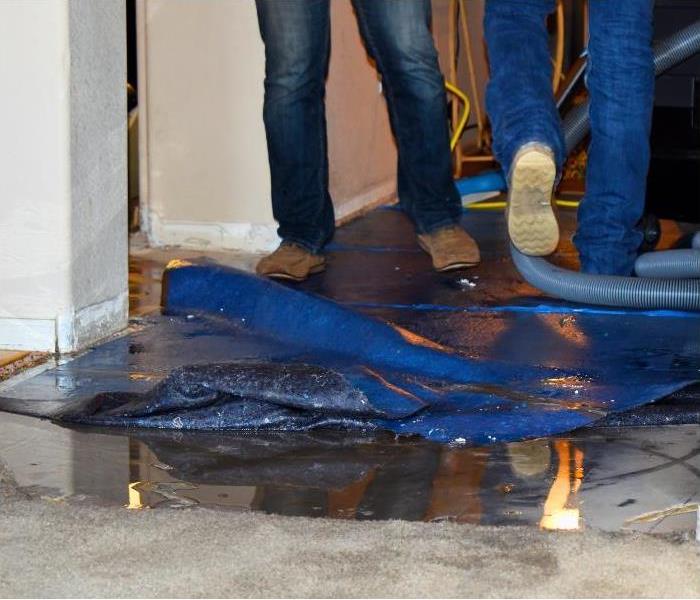Storm Damage Remediation Steps in Salt Lake City, UT: A Comprehensive Guide
7/3/2024 (Permalink)
Salt Lake City, nestled against the picturesque backdrop of the Wasatch Mountains, enjoys its fair share of natural beauty and outdoor activities. However, like many places, it is also susceptible to severe weather events, including storms that can wreak havoc on homes and properties. From heavy rains to fierce winds and occasional snowstorms, these weather patterns can lead to significant damage, requiring prompt and effective remediation efforts.
1. Understanding Storm Damage
Storm damage in Salt Lake City can take various forms depending on the season and the severity of the weather event. Common types of storm damage include:
Roof Damage: High winds and heavy precipitation can cause shingle damage, leaks, or even structural issues to roofs.
Water Damage: Flooding from heavy rains or snowmelt can infiltrate homes, causing damage to walls, floors, and belongings.
Tree Damage: Falling branches or uprooted trees can damage roofs, windows, and siding.
Siding and Window Damage: Strong winds can impact siding and windows, leading to cracks, breaks, or complete detachment.
Foundation Issues: Excessive rain or snowmelt can saturate the soil around foundations, potentially causing shifts or cracks.
2. Immediate Steps After a Storm
When a storm hits Salt Lake City and damages your property, taking immediate action is crucial to mitigate further harm and begin the remediation process:
Safety First: Ensure everyone's safety. If there are any immediate hazards such as downed power lines or structural instability, evacuate the premises and contact emergency services.
Assess Damage: Conduct a thorough inspection of your property to assess the extent of the damage. Document everything for insurance purposes, including taking photos or videos if possible.
Temporary Repairs: If safe to do so, undertake temporary repairs to prevent further damage. This could include tarping a damaged roof, boarding up broken windows, or drying out waterlogged areas.
Contact Your Insurance Provider: Notify your insurance company as soon as possible to begin the claims process. Provide them with detailed documentation and keep records of all communications.
3. Steps for Storm Damage Remediation
Once the initial steps are completed, the process of storm damage remediation in Salt Lake City typically involves several key phases:
1. Water Damage Restoration
If your home has suffered from flooding or water infiltration:
Water Extraction: Use pumps and vacuums to remove standing water from affected areas.
Drying and Dehumidification: Employ industrial-grade dehumidifiers and air movers to thoroughly dry out walls, floors, and carpets.
Mold Prevention: Treat potential mold growth areas with antimicrobial solutions to prevent mold and mildew formation.
2. Roof and Structural Repairs
Addressing roof and structural damage is crucial for ensuring the integrity of your home:
Roof Inspection and Repair: Hire qualified professionals to inspect and repair roof damage. This may involve replacing missing shingles, repairing leaks, or even replacing sections of the roof if necessary.
Structural Assessment: Check for any structural damage to walls, ceilings, or foundations. Reinforce or repair as needed to maintain stability.
3. Siding, Window, and Exterior Repairs
Repair or replace damaged siding, windows, and other exterior components:
Siding Replacement: Replace cracked or detached siding panels to restore insulation and aesthetic appeal.
Window Repair or Replacement: Repair broken windows or replace them with energy-efficient alternatives.
Exterior Inspection: Conduct a thorough inspection of exterior walls and surfaces for hidden damage that could lead to future issues.
4. Landscape and Tree Care
Address any landscaping issues and remove hazards posed by fallen trees or branches:
Tree Removal: Safely remove fallen trees or branches that pose a risk to structures or safety.
Landscape Restoration: Repair landscaping features such as gardens, fences, or pathways damaged during the storm.
5. Final Inspections and Documentation
Once remediation efforts are complete, perform final inspections to ensure all repairs meet safety and quality standards:
Quality Assurance: Verify that all repairs and replacements have been completed to your satisfaction.
Documentation: Keep detailed records of all repairs, receipts, and communications with contractors and insurance providers for future reference.
Navigating storm damage remediation in Salt Lake City requires a proactive approach, attention to safety, and timely coordination with professionals and insurance providers. By following these comprehensive steps, homeowners can effectively restore their properties and minimize the long-term impact of severe weather events. Remember, prompt action and thorough documentation are key to a successful recovery from storm damage.

 24/7 Emergency Service
24/7 Emergency Service
